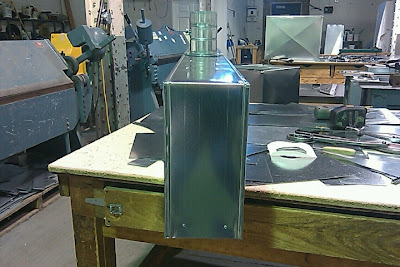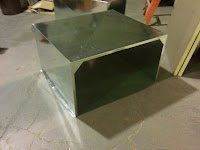Here is what I am working on this afternoon. A customer needs a door fabricated to fit on this pre-made 12" round fitting. So, after a bit of drawing and thought, I came up with an idea for a frame that I can fabricate separately and bolt on. Today was the day to build the shell of the door frame and map out where to cut the hole on the pre-made 12" round Y-fitting.
Here is the pre-made fitting that
I will attach a door frame and door. The frame will be 12" wide by 14" tall and will wrap around the back side of the fitting.
Below is the template that I have cut for the top and bottom side of the door frame. I have left 2" of material so that I can bend a 3/4" flange that will run along the inside of the frame. This is so the door that I fabricate later will have something to sit against when closed.
By the magic of pictures, the flat template has been bent into what will become the top and bottom of my frame. I will need two total of these and two total of what will be the sides of the frame. Those are just basic flat templates with the same bend and flanges. I made an executive decision and left those pictures out.
Below is the finished frame which I will attach to the pre-made 12" Y-fitting that was shown above. This is only the frame, I will later need to make a door that will fit inside and sit on the 3/4" flanges around the inside of the fitting. All of the fabrication was done with bends and Pittsburgh joints. We do not weld anything at our shop. (except for stick pins used for insulating duct)
Now that the frame is complete, I will place it on the pre-made fitting so I can get my measurements for cutting a hole in the 12" Y-fitting. The hole on the fitting will end up being roughly 10" wide by 12" tall. See photo below.
Starting tomorrow I will cut the hole and start to attach the door frame to the 12" round fitting. This actual job order doesn't need to be completed for a few days, so I am working on it in between other orders that need to be finished first.
These are the types of projects that break up the monotony of fabricating stock duct fittings and trunk duct. I will have another post to show the next few steps in a few days.





















